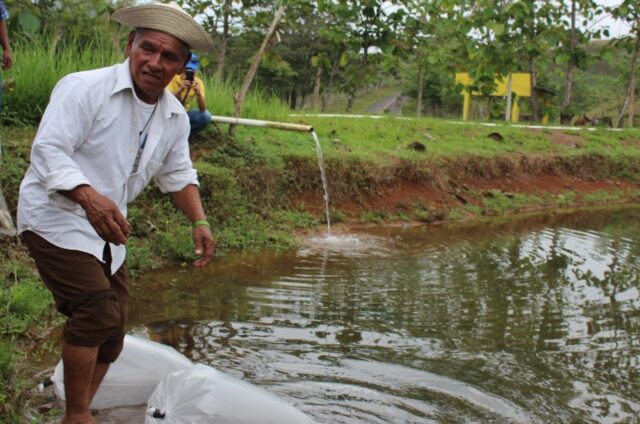Microalgae used as a supplement in feed for farm-grown fish serve to improve the health of animals, increasing productivity. They also have the potential to partially replace the expensive protein that forms the central part of concentrates and thus mitigate the environmental footprint produced in their manufacture.
This was determined by the “Decarbonized Aquaculture” research, implemented by specialists from the Microalgae Laboratory of the Biotechnology Research Center (CIB) of the TEC and financed by the European Union (EU), under the international cooperation model of Development in Transition (DiT). ), a program coordinated by the Ministry of National Planning and Economic Policy (Mideplan), within the strategy of the National Strategic Plan 2020-2050.
The ambitious project, executed in 2022 and 2023, contemplated several aspects to support aquaculture in the country’s coastal and border communities:
-Research into nutritional supplement for fish.
-Identification of needs of producers.
-Training in production and administrative management issues.
-Couple the aquaculture production project to an aquaponics system that uses a circular economy model, to improve profits and reduce environmental impact.
-Reduction of the carbon footprint.
For the master’s degree Maritza Guerrero Barrantes, who until her retirement was the coordinator of the Microalgae Laboratory, she chose to work in aquaculture “because it is a growing activity in the country, especially with the great efforts that Incopesca and the country are making in this line. In addition, it has a very great potential for economic development for rural areas and women, while providing high-quality protein with notable benefits for human health.”
Encouraging results
For more than a year, TEC specialists studied the effects of adding microalgae to the food given to fish, particularly tilapia, in aquaculture cultures. Studies show that microalgae definitely improve the diet of fry, which has positive effects on the development of their immune systems and growth. In this way mortality is reduced, having a positive economic effect for production.
Using several fish tanks, the researchers tested different types of microalgae concentrations in the food. Thus they verified its usefulness to promote the health of the fish. The French intern CorentinGouzien, from the Institut Agro Rennes-Angers, also participated in the project.

Greater efficiency in absorption of nutrients
“The incorporation of microalgae into diets has allowed fish to have a higher survival rate. We have made evaluations in the early stages, in which the fish are very susceptible to stress conditions due to competition between them, and the incorporation of microalgae has allowed for greater efficiency in the absorption of some nutrients, improvements in the intestinal part, which translates into healthier fish,” explained FabiánVillalta Romero, another of the researchers at the Microalgae Laboratory.
These results create excitement in producers throughout the country, who have seen how TEC specialists, accompanying representatives from the Costa Rican Institute of Fisheries and Aquaculture (Incopesca) or the Ministry of Agriculture and Livestock (MAG), visit their farms to Know their problems and propose solutions.
“For us this is something super important, because one of the difficulties we have had is that food is very expensive. When the TEC comes to accompany us, to advise us and to tell us that there are possibilities that your inputs will go down a little, with the new food based on microalgae, that is something wonderful. Because I think that many people have started projects like these and perhaps what has made them abort the project has been the high cost of food for the tilapia,” explained Josefa Fonseca Mora, manager of Coopetilaco, a joint venture of 11 families, the community of Coco, in Siquirres.
“Microalgae as such capture CO2 directly, so there is a direct capture and therefore the carbon footprint is reduced. There are also avoided footprints, because with microalgae we avoid part of the carbon generation when producing animal feed. Another important factor is that we are promoting local production of fish, which reduces the carbon footprint due to transportation,” says Eng. Mauricio Chicas Romero, M.Sc., TEC Researcher.
Reduce pressure in the oceans
But in addition to this encouraging result, researchers believe that in the near future, more than a supplement, microalgae could become the basis of the diet of fish raised in farms.
According to Mauricio Chicas Romero, most of the food given to fish in the current aquaculture model is based on fish meal, produced with fish extracted from the sea. This leads to the absurd figure that for every kilogram of fish produced on land, up to two kilograms of fish taken from the sea are needed. Microalgae could replace fishmeal and thus reduce pressure from overexploitation in our oceans.
“The project was born because microalgae are a very good source of good quality protein and are used for animal feed. So the plan is to replace part of the protein that makes up animal food. At this moment we are replacing up to 20% and that of course will reduce the fish requirement. Since microalgae are something that we can grow right here in Costa Rica, of course it will also reduce costs,” argues Chicas.
“TEC training is very important. We have discovered basic things like the type of food, the ideal temperature for fish, how to know if the water is contaminated or not, the type of tool. It is important knowledge for us to be successful,” stated Jeffrey Lacayo Blanco, producer of the Maleku indigenous community
Meeting needs
Part of the project has consisted of approaching producers throughout the country, with the support of Incopesca and the MAG. This is how the team carried out visits and training in the four coastal and border provinces of the country, in communities such as Sarapiquí, in Heredia; Guápiles and Siquirres, in Limón; Buenos Aires, Golfito, Barranca and Pitahaya, in Puntarenas; San Carlos, Guatuso, Venecia and Upala, in Alajuela, and Cañas and San Miguel, in Guanacaste.
“Among the main objectives of the project is to identify the needs that producers in different regions of the country currently have, in terms of training and crop management. So, to solve these identified needs, targeted training and courses were prepared on crop management,” Murillo explained.
However, the researcher explained, a great need for improvement was also identified in the administrative management of Tilapia producer organizations, particularly in issues such as formalization of ventures, health records or production control.
“We realized that beyond the management of Tilapia farming, it is necessary for producers to know more about correct administration. It is a key point for the project to be profitable, because it allows producers to manage costs and also production and profit from sales,” Murillo added.
So far, the project has provided training to a total of 62 aquaculturists, of which 22 are women and 40 are men.Likewise, virtual training is being developed to share the knowledge acquired during the Decarbonized Aquaculture project with all Tilapia producers in the country.
At the national level, it is estimated that there are approximately 300 companies dedicated to aquaculture, which generate around 2,000 direct jobs. It is important to highlight that Tilapia farming represents 69% of these jobs, which highlights its relevance in the sector.

